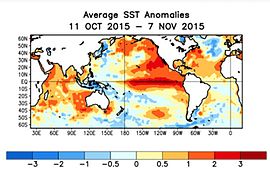2014-16 El Nino event
The 2014–16 El Niño was a warming of the eastern equatorial Pacific Ocean that resulted in unusually warm waters developing between the coast of South America and the International Date Line. These unusually warm waters influenced the world's weather in a number of ways, which in turn significantly affected various parts of the world. These included drought conditions in Venezuela, Australia and a number of Pacific islands while significant flooding was also recorded. During the event more tropical cyclones than normal occurred within the Pacific Ocean, while fewer than normal occurred in the Atlantic Ocean.
The 1997–98 El Niño event was regarded as one of the strongest El Niño events in recorded history, which resulted in widespread drought, flooding and other natural disasters occurring across the globe. Afterwards the climate of the Pacific Ocean was dominated by a cool phase of the Pacific decadal oscillation, with three significant La Niña events occurring between 1998–2001, 2007–09 and 2010–12. Despite the La Niña background to the Pacific Climate, four El Niño events occurred during 2002–03, 2004–05, 2006–07, and 2009–10, but each were weaker and had shorter effects than the 1997-98 event. After the 2010–12 La Niña event had ended, near-neutral conditions persisted over the Pacific Ocean with no La Niña or El Niño events occurring. An intense burst of typhoon activity subsequently took place between September and November 2013, which was thought to possibly be a precursor signal to an impending change of the Pacific climate towards El Niño rather than La Niña.
During January 2014, after surveying various climate models, the World Meteorological Organization warned that there was an enhanced possibility of a weak El Niño event happening during 2014. Over the next few months the climate of the Pacific Ocean started to exhibit features that suggested the impending onset of an El Niño event. Over the ocean, these features included: a rapid fall of the sea level in western Micronesia, as well as a large area of enhanced sea surface temperatures that were present at low latitudes near the International Date Line. In the atmosphere these features included persistent westerly winds at equatorial latitudes, which were displaced eastwards towards the Marshall Islands. A large area of atmospheric convection was present at a low latitude near the International Dateline, in association with the development of an unusual amount of early season tropical cyclones near the Marshall Islands. As a result of some of these conditions, an El Niño Watch was issued by the United States Climate Prediction Center (NOAA's CPC) and the International Research Institute for Climate and Society within their March 2014 diagnostic discussion.
...
Wikipedia

